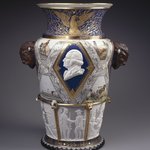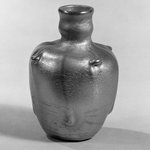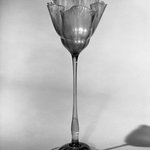
Bowl
Decorative Arts and Design
On View: Decorative Art, 20th-Century Decorative Arts, 4th Floor
Although Louis Comfort Tiffany also designed mosaics, ceramics, lighting, jewelry, metalwork, and interiors, he is perhaps best known for his work in glass. Tiffany, a son of the founder of the New York jewelry and silver firm Tiffany and Company, had already earned a reputation for his interiors and stained-glass windows when in 1893 he established what would become Tiffany Studios, a glass factory in Corona, Queens, with the English glassblower Arthur Nash. Together they developed a new type of blown glass that stood out for its embedded iridescent colors, metallic luster, and satiny surfaces. Tiffany named the glass Favrile, borrowing from the Old English word fabrile, referring to handwork. It was Nash, however, who invented the glass formula, which he kept a closely guarded secret—even from Tiffany himself. Tiffany Studios did not produce all the Favrile shades for their bronze lamps themselves. The studio collaborated with the New York City firm of Quezal Art Glass and Decorating Company, for example, on the lamp with lily-flower shades seen here.
Tiffany was inspired by ancient Roman and Syrian glass, which, when it was buried in the earth, had turned iridescent as it reacted to the minerals in the soil. Tiffany produced Favrile glass in a dizzying array of shapes, sizes, colors, and patterns. He considered the pieces to be works of art and actively endeavored to place them in museum collections.
Tiffany Studios also manufactured popular but expensive bronze and brilliantly colored stained-glass lamps suitable for the recently invented electric light bulb. Clara Driscoll, head of the Women’s Glass Cutting Department at Tiffany Studios, was responsible for the design of this Dragonfly lamp. During the late nineteenth and early twentieth centuries, women played increasingly important design and fabrication roles in the production of decorative arts, including ceramics, glass, and furniture.
Tiffany was inspired by ancient Roman and Syrian glass, which, when it was buried in the earth, had turned iridescent as it reacted to the minerals in the soil. Tiffany produced Favrile glass in a dizzying array of shapes, sizes, colors, and patterns. He considered the pieces to be works of art and actively endeavored to place them in museum collections.
Tiffany Studios also manufactured popular but expensive bronze and brilliantly colored stained-glass lamps suitable for the recently invented electric light bulb. Clara Driscoll, head of the Women’s Glass Cutting Department at Tiffany Studios, was responsible for the design of this Dragonfly lamp. During the late nineteenth and early twentieth centuries, women played increasingly important design and fabrication roles in the production of decorative arts, including ceramics, glass, and furniture.
MEDIUM
Favrile glass
DATES
ca. 1901–1905
DIMENSIONS
7 x 10 x 10 in. (17.8 x 25.4 x 25.4 cm) (show scale)



MARKINGS
Scratched on the bottom: "R2418"/"Louis C. Tiffany" with paper oval label marked "125oo".
COLLECTIONS
Decorative Arts and Design
ACCESSION NUMBER
14.739.14
CREDIT LINE
Gift of Charles W. Gould
EXHIBITIONS
MUSEUM LOCATION
This item is on view in Decorative Art, 20th-Century Decorative Arts, 4th Floor
CAPTION
Tiffany Studios (1902–1932). Bowl, ca. 1901–1905. Favrile glass, 7 x 10 x 10 in. (17.8 x 25.4 x 25.4 cm). Brooklyn Museum, Gift of Charles W. Gould, 14.739.14. Creative Commons-BY (Photo: Brooklyn Museum, 14.739.14.jpg)
IMAGE
overall, 14.739.14.jpg. Brooklyn Museum photograph
"CUR" at the beginning of an image file name means that the image was created by a curatorial staff member. These study images may be digital point-and-shoot photographs, when we don\'t yet have high-quality studio photography, or they may be scans of older negatives, slides, or photographic prints, providing historical documentation of the object.
RIGHTS STATEMENT
Creative Commons-BY
You may download and use Brooklyn Museum images of this three-dimensional work in accordance with a Creative Commons license. Fair use, as understood under the United States Copyright Act, may also apply.
Please include caption information from this page and credit the Brooklyn Museum. If you need a high resolution file, please fill out our online application form (charges apply).
For further information about copyright, we recommend resources at the United States Library of Congress, Cornell University, Copyright and Cultural Institutions: Guidelines for U.S. Libraries, Archives, and Museums, and Copyright Watch.
For more information about the Museum's rights project, including how rights types are assigned, please see our blog posts on copyright.
If you have any information regarding this work and rights to it, please contact copyright@brooklynmuseum.org.
RECORD COMPLETENESS
Not every record you will find here is complete. More information is available for some works than for others, and some entries have been updated more recently. Records are frequently reviewed and revised, and we welcome any additional information you might have.










































